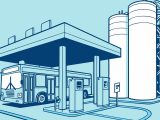
Hydrogen Infrastructure Drives Fuel Cell Truck Rollout at Rotterdam Port
November 20, 2025Air Liquide and the Port of Rotterdam Authority kicked off Europe’s boldest hydrogen trucking project yet. They’re rolling out heavy-duty trucks powered by hydrogen fuel cells across the Netherlands—a huge leap for industrial decarbonization in logistics. With plans for 1,000 H2 rigs (half of them in Rotterdam) and 25 high-capacity refueling spots, they’re setting a frantic pace for zero-emission technology transport from the Benelux into Germany.
From Prototype to Fleet
This isn’t a first rodeo. Air Liquide, in the hydrogen game since 1902, brings over fifty years of hydrogen know-how—from production and storage to dispensing. And the Port of Rotterdam, Europe’s busiest seaport, has been experimenting with low-carbon fuels and infrastructure fixes for years. Now, they’re scaling up, moving from pilots to full-blown commercial ops that could flip the script on how Europe moves its goods.
A Legacy of Hydrogen Development
Hydrogen’s been part of Europe’s industrial backbone for decades. Air Liquide has supplied it to refineries, chemical plants and mobility pilots for over 50 years. Thanks to the EU’s IPCEI scheme, billions have fueled hydrogen R&D and grid build-out. In the Netherlands, national subsidies and booming renewables have paved the way for large-scale electrolysis. And at the port, trials in hydrogen bunkering for inland vessels and ammonia cracking have turned Rotterdam into a hotbed for clean fuels.
How Hydrogen Trucks Work
- Onboard storage: Pressurized H2 tanks that give you diesel-like range.
- Fuel cell operation: Pro-grade electrochemical stacks turn hydrogen and oxygen into electricity, power the motors—and all you get is water vapor.
- Rapid refueling: High-capacity stations top up trucks in under 20 minutes—just like a diesel stop.
These rigs tap into mature fleet-proven fuel cell technology to hit the uptime and performance benchmarks logistics pros demand.
Scaling Infrastructure
At the heart of this push is a 25-station network spanning the Netherlands, Belgium and western Germany. Each station is built for fast turnarounds and 24/7 operation, slashing range anxiety and guaranteeing a steady supply of green hydrogen made by electrolysis, backed by the region’s ramped-up renewables.
Strategic Partnerships
To stitch together the full value chain, Air Liquide and Rotterdam Authority have looped in:
- Truck makers: VDL Groep, Iveco and Nikola
- Logistics carriers: Vos Logistics, Jongeneel Transport and HN Post
- Fuel cell and equipment suppliers
By uniting OEMs, carriers and infrastructure experts, they’re driving down costs and fast-tracking adoption.
Regional Ripple Effects
This project isn’t just about slashing emissions. Building those 25 stations sparks jobs in engineering, construction and upkeep. As production volumes climb, truck builders and fuel cell developers will see costs tumble. Operators running hydrogen fleets get to advertise ultra-clean credentials, wooing shippers chasing green supply chains. Before long, you’ll see training programs, service hubs and innovation clusters popping up around the port and along hydrogen corridors.
Where Hydrogen Stands
Battery-electric trucks are nailing urban haulage, but charging times and weight limits hold them back on long hauls. Hydrogen fuel cell trucks, on the flip side, top up fast and match diesel ranges. As green hydrogen production ramps up, analysts predict fuel cell fleet costs will near diesel parity by the early 2030s—a game-changer for the heaviest hauls.
Impact on Emissions and Air Quality
Heavy trucks punch way above their weight when it comes to CO₂ and particulate output. This new fleet is set to cut over 100,000 tonnes of CO₂ yearly and almost wipe out NOₓ and fine particulates at the port. That cleaner air is a win for dockworkers, residents and the environment alike.
Economic and Policy Drivers
The EU’s push for climate neutrality and the Netherlands’ drive to cut transport emissions give this initiative serious tailwind. Subsidies for green hydrogen, perks for clean fleets and tougher emissions rules all point to the same endgame: ditching diesel. For Rotterdam, it solidifies its role as an energy transition hub, drawing more investment in zero-emission technology and sustainable energy solutions.
Challenges Ahead
Of course, it isn’t all smooth sailing. Erecting 25 stations means big upfront capital, and electrolyzer capacity has to keep pace to ensure truly low-carbon supply. The business case relies on steady policy support and falling green hydrogen costs. Still, everyone’s rallying around the cause, so the odds look good.
Next Moves
In the coming months, the first 500 trucks in Rotterdam roll into regular service, linking container terminals, distribution hubs and industrial parks. Meanwhile, Air Liquide will crank up green hydrogen production with new and existing electrolyzers, and station builds will surge toward that 25-point network, opening routes across the region.
The Road to Scale
If it works, this could be the blueprint for hydrogen logistics corridors all over Europe. Ports, road haulers and policymakers will be watching every milestone. The lessons from Rotterdam—on fleet ops, infrastructure rollouts and public-private teamwork—could fast-track Europe’s shift away from diesel.
With emissions regs tightening and customers demanding greener supply chains, hydrogen fuel cells and robust hydrogen infrastructure are set to play starring roles. This partnership between Air Liquide and the Port of Rotterdam Authority isn’t just a showcase—it’s a bold step toward a decarbonized transport future. Now, the big question is: how fast can we replicate this success across Europe’s arteries?


 With over 15 years of reporting hydrogen news, we are your premier source for the latest updates and insights in hydrogen and renewable energy.
With over 15 years of reporting hydrogen news, we are your premier source for the latest updates and insights in hydrogen and renewable energy.